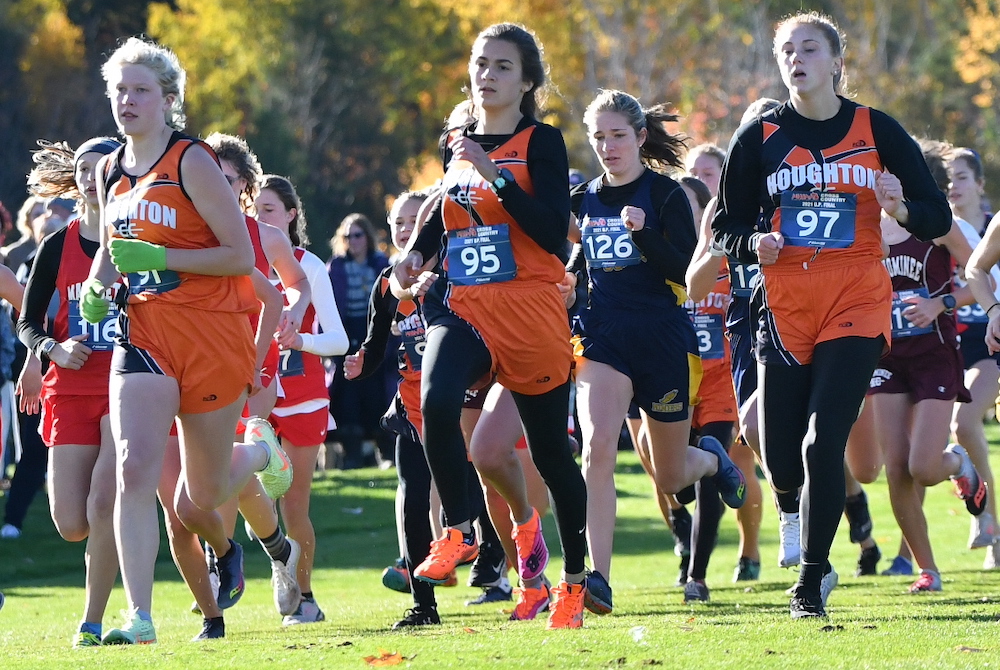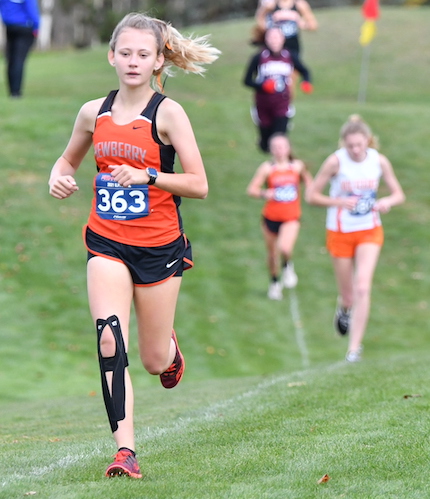
1st-Time Individual Champs, Perennial Team Powers Rule UP Girls Finals
By
John Vrancic
Special for MHSAA.com
October 23, 2021
MARQUETTE — Houghton and Hancock often see each other during the course of a cross country season.
It was a happy ending for the girls teams from both schools as they were crowned champions during the Upper Peninsula Finals here Saturday.
Houghton retained its Division 1 title with 52 points, followed by Marquette with 69, Negaunee 83 and Sault Ste. Marie 99.
Hancock won Division 2 for the third time in four years with 43 points, followed by Ishpeming with 54 and Ironwood 72.
“This was our best performance all year,” said Hancock coach Jennifer Smith. “The girls peaked today, which is exactly what they needed to do. We were runners-up by one point to St. Ignace last year and really wanted to take (the title) back. We needed everybody at the top of her game.
“I hope the girls continue to run. I also hope the middle school runners keep running, too.”
 In Division 1, Houghton senior Ingrid Seagren earned her first individual title, covering the 3.1-mile course at Gentz’s Homestead Golf Course in Chocolay Township in 20 minutes, 51.7 seconds. She was followed by Sault Ste. Marie junior Cassandra Gallagher (21:05.8) and Houghton junior Claire Filpus (21:11.2).
In Division 1, Houghton senior Ingrid Seagren earned her first individual title, covering the 3.1-mile course at Gentz’s Homestead Golf Course in Chocolay Township in 20 minutes, 51.7 seconds. She was followed by Sault Ste. Marie junior Cassandra Gallagher (21:05.8) and Houghton junior Claire Filpus (21:11.2).
“This has been my goal for a long time,” said Seagren. “There was a lot of pressure on us to win again, and we pushed each other real hard all year. I’m super proud of Paige (Sleeman) and Claire. You always want to peak for this race, but it’s really hard.”
Houghton senior and 2020 individual champion Paige Sleeman finished eighth this time (21:23.3), marking the fifth straight Finals she placed in the top 10 and was part of a U.P. championship team.
“It’s exciting and unbelievable,” said Sleeman, who was part of three championship teams at Chassell and now two at Houghton. “I never thought I’d be part of this many U.P. championship teams. I just developed a run for this sport, and the girls I ran with are amazing. Ingrid ran great. I knew it was going to be close race among the top four teams. For me, I just wanted to get the team win.”
Houghton coach Traci Welch had similar thoughts.
“They really wanted to give it their all,” she said. “Paige battled some illness, and she just went out and did what she needed to do. Claire missed last year (due to COVID), but now she’s healthy and very motivated. Our fourth and fifth runners (freshman Kiira Niska and junior Jewel Laux) were so important to the team. Jewel had COVID and came back and did great. All the teams ran hard. It boiled down to who had the best race today.”
Ishpeming sophomore Lola Korpi gained her first U.P. title in a season-best 20:04.9 to win Division 2. She was followed by Ironwood freshman Aubrey Smith (21:41.1) and Gogebic (Bessemer) junior Natalie Stone (21:56.8).
“I just gave it my all because it was the last race this year,” said Korpi. “I’m a little surprised by the margin of victory. The Ironwood girl is a good runner. We got two more runners at the last minute and we’re just so happy about that. I’m so proud of them for coming out of their comfort zone.”
Munising, which placed four in the top 10, repeated as Division 3 champion with 31 points, followed by Dollar Bay with 71 and Eben Junction Superior Central with 99.
 “It’s exciting to win it again,” said senior Jenna Matson, who placed sixth (22:43.2). “That wasn’t one of my better times, although we won as a team which is all that matters. We’re a pretty tight group. I was shooting for under 22, but I’m okay with that.
“It’s exciting to win it again,” said senior Jenna Matson, who placed sixth (22:43.2). “That wasn’t one of my better times, although we won as a team which is all that matters. We’re a pretty tight group. I was shooting for under 22, but I’m okay with that.
“Our No. 5 runner (freshman Kate Mattson) didn’t place, yet we wouldn’t have won if it wasn’t for her. I felt there was a little more pressure on us this time, but our coach (Mark Kinnunen) kept us together and got what we needed.”
Newberry sophomore Kaylen Clark won her first Finals championship at 20:50.4. She was followed by Rock Mid Peninsula senior Landry Koski (21:37.9) and Munising junior Monique Brisson (21:51).
“The course was more challenging than I expected,” said Clark. “We had one hill before you turn into the last stretch that was real challenging. I had to go out strong because I knew the Mid Pen girl was a good runner, and she had a great race. This was a good showing for our team.”
Koski, who won on this course as a sophomore two years ago, was happy with her runner-up finish.
“I knew coming in the Newberry girl was fast,” she said. “She took off real fast. I knew after the first mile I wasn’t going to be able to catch her. I didn’t know what to expect from her because I hadn’t run against her all season.”
Brisson said her strategy was to keep up with Koski.
“Landry is a very strong runner,” she added. “Kaylen ran a real good race. I was surprised by her time.
“We’re all friends. It’s friendly competition. I’m real happy for Landry with this being her senior year. I’m so proud of our team. Jenna pushed me real hard all year.”
Click for full results: Division 1 | Division 2 | Division 3.
PHOTOS (Top) Houghton's Claire Filpus (91), Ingrid Seagren (95), and Paige Sleeman (97) pull into the lead near the start of the Division 1 race. (Middle) Ishpeming’s Lola Korpi sets the pace for the lead pack during the Division 2 Final. (Below) Newberry’s Kaylen Clark builds her lead on the way to winning the Division 3 championship. (Photos by Cara Kamps. Click for more from RunMichigan.com.)

MHSAA Vault: MIS Rose to Challenges to Host 2020 LP Finals
By
Rob Kaminski
MHSAA benchmarks editor
November 12, 2021
The “MHSAA Vault” features stories from past publications and other documents in the MHSAA Library. This issue takes a look at the MHSAA Cross Country Finals at Michigan International Speedway, which celebrated 25 years in 2020 – although it was an event that nearly didn’t happen last fall …
In 1996, the MHSAA and Michigan International Speedway began a partnership the changed the course of the Lower Peninsula Cross Country Finals – quite literally.
The land in and around the track at Brooklyn would host the Finals for all classes of runners in one place on one day, an annual festival of nearly 2,000 runners competing for the MHSAA’s top honors.
Even skeptics – and there were several among running purists who thought the course was too flat, for example – can’t deny the results.
Finals attendance nearly doubled in that first year, and crowds in excess of 10,000 have enjoyed a day of racing several times, including a record 12,153 in 2011.
Enthusiastic crowds were the norm in recent years, with 11,232 in 2017, and nearly 11,000 in 2018 (10,989) and 2019 (10,873).
In fact, attendance failed to reach at least 8,000 only twice since the move to MIS.
Of course, last year was an exception, when attendance was limited to 1,000 spectators per session due to the COVID-19 Pandemic. Fans also were restricted to the grandstands rather than following the action throughout locations on the course.
To reduce the number of runners in each race, the event was spread over two days, with each Division being run in two separate “sections” with times then combined at the end to determine team and individual champions.
While not ideal, the end result was another year of fantastic efforts at MIS – both from student-athletes and those behind the scenes.
“Even at the last hour, less than a week ahead of the Finals, we were closer to not having the Finals than we were to having them,” said MHSAA Assistant Director Cody Inglis, who coordinates the cross country postseason. “Rumors and challenges of mandated shutdowns, testing and other requirements were being discussed and caused a lot of unknowns. Even at the Regional level, we had schools, Regional courses and hosts shutting down their facilities; we had to relocate four Regionals 48 hours prior to race times. That scenario just could not happen at the Finals level where far more runners and much more travel would be involved.”
Among the many last-minute hurdles was the edict from NASCAR – which owns MIS – that all persons on site be temperature checked upon entry. That meant securing thermometers that were easy to operate in short order, along with personnel necessary to conduct the readings.
The attendance limitations certainly helped to implement the temperature screening, but brought their own issues.
“Limiting spectators was not a popular decision, but it really was the only way to have a race,” Inglis said. “We were taking direction and working with policies and protocols from the MDHHS, the Governor’s office, Lenawee County Health Department, MIS and NASCAR.”
Part of the solution was to utilize the grandstands as a “barrier” between participants and spectators. The reduced number of fans were dispersed over thousands of seats while still allowing them the chance to watch their student-athletes compete.
“It wasn’t the same, it wasn’t easy or perfect, but it was what we had to do to have a race,” Inglis said. “Separating the Finals into two days and different sections also allowed us to spread out the event and limit the number of people on site at any one time. This was a key part of the plan and worked well even though it separated races within a Division.”
The MHSAA, MIS and the cross country community never lost focus of the main goal: a culmination of the season for the student-athletes, who deserved something last year more than ever. And, more than ever, MIS once again displayed its advantage as a venue that could adapt to the fluid nature of the times to pull off the event.
“There were some thoughts of using four different sites, but as we learned during the Regionals, the climate of things was so tenuous from one area of the state to another that we couldn’t be 100-percent certain that there wouldn’t again be last-minute cancelations,” Inglis said. “MIS was wonderful to work and collaborate with, and was the best option to get it done. It was never mentioned once publicly about the possibility of not having the Finals – only how we could best do it under uncharted conditions.”
The moving parts and ever-changing scenarios created more complexity than ever in finalizing a season, but every decision was made with the complete desire to conduct the Finals as close to normal as possible.
“I firmly believe that a finish to the season, no matter the differences in race formatting and fan experience, was something everyone would have taken when the season began in August,” Inglis said.
Indeed, the finish line in Year 25 at MIS might have been the most gratifying of them all.

